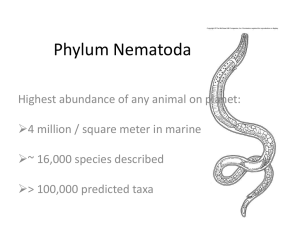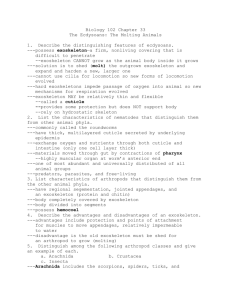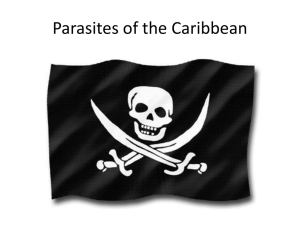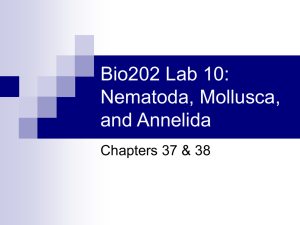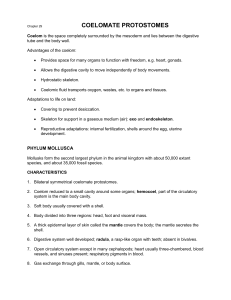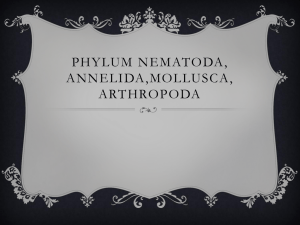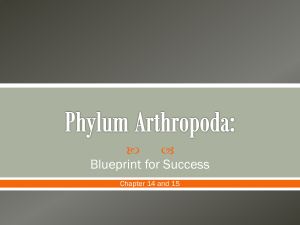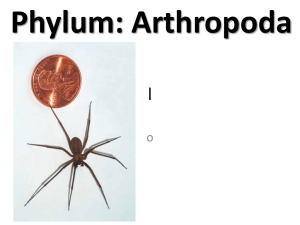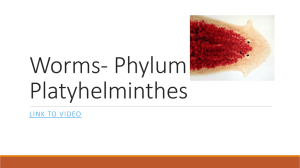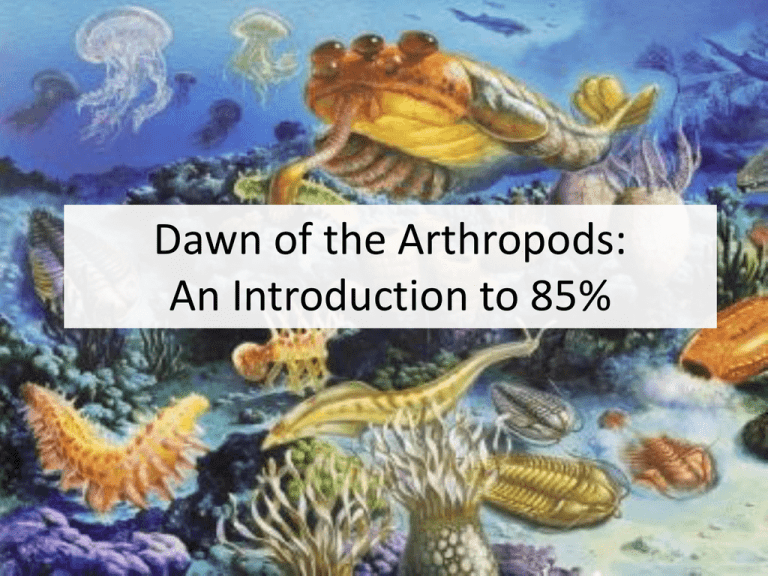
Dawn of the Arthropods:
An Introduction to 85%
The Arthropods
• First arthropods Early Cambrian 600 mya
– All environments, diverse ecologies
– Tiny mites + crustacea < 1 mm --- Japanese
spider crabs 3 m long
– 85% of described animal taxa
– 3 - 100 million species
Tardigrades and Onychophorans
Similar to Arthropods
• chitinous cuticles
Phylum Tardigrada
• ~900 species
• 50 – 1200 µm
•Surface films of freshwater on terrestrial plants,
mosses and lichens
•abundant (3 million m-2)
Phylum Tardigrada
Defining characteristic:
mouthparts: protrusible, oral stylet for piercing plant
and animal tissues to obtain fluids
Phylum Tardigrada
• chitinous cuticle lining outer surface and gut
• arthropod-like striated muscles
• hemocoel
• gas exchange across body surface
• NO RESPIRATORY STRUCTURES
• lack cilia
• 4 pairs of clawed appendages (non-jointed)
Phylum Tardigrada
• nervous system similar to arthropods
• paired ventral nerve cord
Phylum Tardigrada
video
• offspring develop as miniature adults
• male deposits sperm into female seminal receptacle
• cuticle never calcified
• cryptobiosis – dehydrate with environmental extremes
• gonochoristic
•ANABIOSIS: reduced metabolism
•CRYPTOBIOSIS: extreme anabiosis
Phylum Onychophora
“velvet worms”
Defining Characteristics:
• 2nd pair of appendages modified into jaws
• 3rd pair of appendages form oral papillae
Phylum Onychophora
“velvet worms”
Defining Characteristics:
• slime glands discharge adhesive through oral papillae
• hydrostatic skeleton
Phylum Onychophora
• ~ 100 species
• moist terrestrial habitat
• thin, non-waxy cuticle
• nocturnal
Phylum Onychophora
• carnivores, herbivores, omnivores
• predators shoot proteinaceaous glue from oral papillae
• some use glue as defense
video
Phylum Onychophora
• circular, longitudinal, and diagonal muscles
• 1 pair feeding appendages
• no jointed appendages
• hydrostatic skeleton
• pair of nephridia / segments
Phylum Onychophora
• Ocelli; no compound eyes, photonegative
• Sperm morphology similar to oligochaetes
and leeches
•Mostly dioecious
•Oviparous, viviparous, or ovoviviparous
•Direct development
Phylum Arthropoda
•
6 classes
• 80 orders
• 2400 families
• Loss of motile cilia
• Segmented, jointed, sclerotized chitinous
exoskeleton
• Flexible joints, hemocoel, Sense organs,
ecdysis, specialized segments (head, thorax,
abdomen)
Phylum Arthropoda: Pechenik Classification
Subphyla:
1) Trilobitomorpha (extinct)
1) Class Trilobita
2) Chelicerata
1) Class Merostomata
2) Class Arachnida
3) Class Pycnogonida
4) Class Eurypterida (extinct)
3) Mandibulata
1) Class Myriapoda
1) Order Chilopoda/Diplopoda
2) Class Hexapoda
1) Subclass Entognatha
2) Subclass Insecta
3) Class Crustacea
Arthropoda Exoskeleton
• water impermeable
• procuticle – mostly chitin
•EXOSKELETON LIMITS CONSTANT GROWTH
Arthropoda: Support and Locomotion
• exoskeleton
• Muscles connect body
segments + joints
• Exoskeleton across
joints NOT absent, but
thin and flexible;
Phylum Arthropoda
•
•
metamerism
most taxa have fused and modified specialized segments
Molting
• exoskeleton covering except for sensory hairs,
gland openings, spiracles
• parts of gut also lined with cuticle
• ecdysis – loss of exoskeleton
Molting
• new cuticle secreted first, but then hardened
• period of vulnerability
• under neural and hormonal control
Arthropoda Nervous System and Sense
Organs
• Brain
• Tactile receptors = bristles or setae
Arthropoda Nervous System and Sense
Organs
•
•
•
•
Brain
Tactile receptors = bristles or setae
Proprioception necessary with jointed appendages
Stretch receptors span joints and provide knowledge of limb
positions
Arthropoda Nervous System and Sense
Organs
•
•
•
•
•
•
•
•
Brain
Tactile receptors = bristles or setae
Proprioception necessary with jointed appendages
Stretch receptors span joints and provide knowledge of limb
positions
Three photoreceptors: simple ocelli, complex lensed ocelli,
compound eyes
Compound eyes: ommitidia
Ommitidium: nerve tracts and field of vision
Visual fields of neighboring ommitidia overlap
– movements detected by each
– compound eyes suitable for detection of subtle movement
Arthropoda Nervous System and Sense
Organs
•
•
•
•
•
•
•
•
Brain
Tactile receptors = bristles or setae
Proprioception necessary with jointed appendages
Stretch receptors span joints and provide knowledge of limb
positions
Three photoreceptors: simple ocelli, complex lensed ocelli,
compound eyes
Compound eyes: ommitidia
Ommitidium: nerve tracts and field of vision
Visual fields of neighboring ommitidia overlap
– movements detected by each
– compound eyes suitable for detection of subtle movement
Visual System
• ocelli or compound eyes
• light sensitive surface with light-absorbing pigment
Circulation and Gas Exchange
• Gas exchange structures = invaginations in
cuticle
• Inwardly branching trachea: hemocoel via
spiracles
• gas exchange with hemolymph
Circulatory System
• heart with ostia = open circulatory system
• hemolymph
Arthropoda Digestive System
• Foregut- ingestion, transport, storage,
mechanical digestion
• Midgut- enzyme production, chemical
digestion, absorption
• Hindgut- water absorption, preparation of
fecal material
Arthropoda Excretion and
Osmoregulation
• Nephridia and malpighian tubules
• nephridial pores excrete concentrated nitrogenous waste
products
• Urine from malpighian tubules to gut, concentrates urine
(reabsorb water)
• Terrestrial arachnids, myriapods, and insects excrete
predominantly uric acid
Arthropoda Repro and Development
• Dioecious
• Fertilization internal, parental care common
Class Trilobita
• 4000 described species
• extinct
• dorsoventrally flattened
• 3 sections
• biramous appendages
Crustacea
• Terrestrial and aquatic
• All depths in marine, brackish, and freshwater
• > 67,000 described species, likely 5-10x that number
• Diverse form, size, and habitat
• 5 classes, 34 orders
Crustacea
Subclass Malacostraca
- Order Isopoda (pillbugs)
- Order Amphipoda (scuds)
- Order Euphausiacea (krill)
- Order Stomatopoda
- Order Decapoda (crabs, shrimp,
lobsters, hermit crabs, crayfish)
Subclass Branchiopoda – brine (monkeys)
Subclass Ostracoda - ostracods
Subclass Copepoda – copepods
Subclass Pentastomida – nasal parasites
Subclass Cirripedia (maxilopoda) – barnacles
Characteristics
• Head = 5 segments, trunk divided into thorax
and abdomen
• Carapace or cephalic shield
• Appendages multi-articulate; either
uniramous or biramous
• Mandibles are modified limbs that function as
jaws
• Gas exchange by diffusion across specialized
surfaces
Characteristics
• Nephridia
• Simple and compound eyes in at least one
stage
– Compound eyes on stalk
• Gut with digestive cecae
• Nauplius larvae, either mixed or direct
development
• 2 pair antennae
Crustacean Bauplan
• Thorax
– anterior segments fused = cephalon
• Maxillipeds: additional mouthparts
• Number of segments in thorax varies
• Thorax appendages = pereopods
– swimming, walking, gas exchange, feeding, defense
– ultiarticulate and biramous
Basic Crustacean Bauplan
• Abdomen
– Segments
– Number of segments used in ID
• Appendages = pleopods
– Biramous, flap-like
– swimming
– Culminate in telson
• Anus
• caudal rami
• w/uropods (last pair of abdominal appendages) forms
tail fan
Adult Crustacean
Crustacean Bauplan
• Nauplius Larvae
– Single, median, simple eye
– 3 pairs of sectioned, functional limbs
• Become antennules, antennae, and mandibles
Circulation
• Open circulatory system
– Dorsal ostiate heart
– Internal organs bathed in fluid
– Simple heart and vessels in most
• Sessile species no heart; pumping vessels
• Blood
– Variety of cell types
• Dissolved hemoglobin or hemocyanin
• Explosive cells release a clotting agent at injury sites
Heart Shape
• Heart long and tubular; to postcephalic region
• Or, globular, box shape, in thorax; association
with thoracic gills
Gas Exchange
• Aquatic
– Small organisms = diffusion
– Concealed gills for protection, prevent dessication
– External gills
• Modified thoracic limbs
• Gills are thin; maximize gas exchange
• Most species beat gills to maintain flow
Gas Exchange
• Terrestrial
– Cutaneous Respiration
• Membranes on legs of some species
– Gills
• Concealed
– Pseudotrachea
• Internal blind sacs to outside through small pores
• Air in sacs, gas exchange with blood
• Internal gills moist
Feeding Strategies
•
•
•
•
•
•
•
•
•
•
Water currents
Hydraulic vacuum
Filter feeding
Feeding basket
Passive
Twirling antennae
Direct manipulation
Sand grazers or Sand lickers
Predators
Parasitism
Water Currents
• Thoracic limbs for swimming and creating
suspension feeding currents
• Water drawn into space
• Particles trapped by setae
• moved to food groove and toward head
Hydraulic vacuum
• Mouth appendages = paddles
• Water containing food drawn into interlimb space
• Food particles are not filtered, but captured in small
parcels of water
• Individual algal cells are captured this way
Filter feeding
• Sessile crustaceans have feathery cirri to filter
feed
• food up to one mm
• = detritus, bacteria, algae and various
zooplankton
• Some can coil cirrus around large prey in a
tentacle fashion
Filter feeding in slow water
• Extend pairs of cirri like a fan
• Sweep rhythmically through water
Filter feeding in fast water
• Allow water to run through filter
• video
Passive feeding
• Use cirri to passively strain
• Burrow into sand with anterior facing upward
• Extend cirri to capture bacteria, protists and
phytoplankton
• Antennae brush food towards mouth
Twirl antennae
• Create spiraling currents that bring food
toward mouth
• Food entangled in setae near base of mouth,
brushed in
Direct manipulation
• Manipulation by
mouthparts,
pereopods and
subchelate anterior
legs
Sand grazers or Sand lickers
• Brush sand grains with setose mouthparts
• Select individual sand grain, rotate and tumble
against mouthparts to remove organic
material
Predator
• Grab prey with chelae pereopods
• Tear, grind and shear with mouthparts
• Hunters or ambushers use raptorial subchelae
to stab, club or smash prey
• Some hold prey in cage using endopods;
others inject and suck out tissues
Snapping Shrimp
• Use large cheliped to snap close: produces
loud popping sound and “shock” wave
• Pressure wave stuns prey, pull into burrow
Digestive system
• Foregut
– Lined with cuticle that is continuous with exoskeleton, molted
– Short pharynx-esophagus, stomach
– Stomach = chambers for storage, grinding and sorting
Midgut
intestine
Length varies with
shape size, diet
digestive ceca
Hindgut
Short, to anus
Excretion and Osmoregulation
• Ammonia by nephridia and gills
• nephridial excretory organs as antennal glands
(green glands) or maxillary glands
• Inner blind end is coelomic remnant of
nephridium = sacculus
Other osmoregulation
• Sacculus - Actively remove and secrete
material from blood into excretory lumen
• metabolic waste removal and water and ion
balance
• Thin areas of cuticle
– Gill surfaces
• terrestrial isopods: ammonia diffuses from the
body as gas
Nervous System and Sense Organs
• CNS
• Brain: three fused ganglia
•
Protocerebrum
•
Deutocerebrum
•
Tritocerebrum
• Primitive nervous system = ladderlike
Nervous System and Sense Organs
• variety of sensory receptors
• innervated setae or sensilla: contain
mechanoreceptors and chemoreceptors
• Propioceptors
• Animals in Class Malacostraca: statocysts
Nervous System and Sense Organs
• Two rhabdomeric photoreceptors:
•
Median simple eyes
•
Lateral compound eyes
• Most possess both, either simultaneously or
during development
• Naupliar eye = primitive, secondarily lost
Nervous System and Sense Organs
•
•
•
•
•
Lateral compound eyes
Lack visual acuity
Discern shapes, patterns and movement
Color vision in some
Lacking in many taxa
Nervous System and Sense Organs
• Underwater vision
• Problems with angular distribution of light, lower intensity,
and narrow range of wavelengths than in air
• Solution: Mount eyes on stalks, increase information
available to eyes. Increases field of view, and binocular range
Nervous System and Sense Organs
• Complex Endocrine and Neurosecretory
Systems
• Not well known
• Molting, chromatophore activity, and
reproduction under hormonal and
neurosecretory control
• Bioluminescence in several groups
Reproduction And Development
• Exploit virtually every life history scheme
imaginable
• Usually dioecious
• Hermaphroditism in remipedes,
cephalocarids, cirripedes, few decapods
• Parthenogenesis common among
branchiopods and certain ostracods
Reproduction And Development
• Gonads paired structures in trunk
• Pair of gonoducts from gonads to genital
pores on trunk segment
• Male pair of penes, or single fused median
penis
• Female include seminal receptacles
• Most Crustacea Copulate in Pairs

